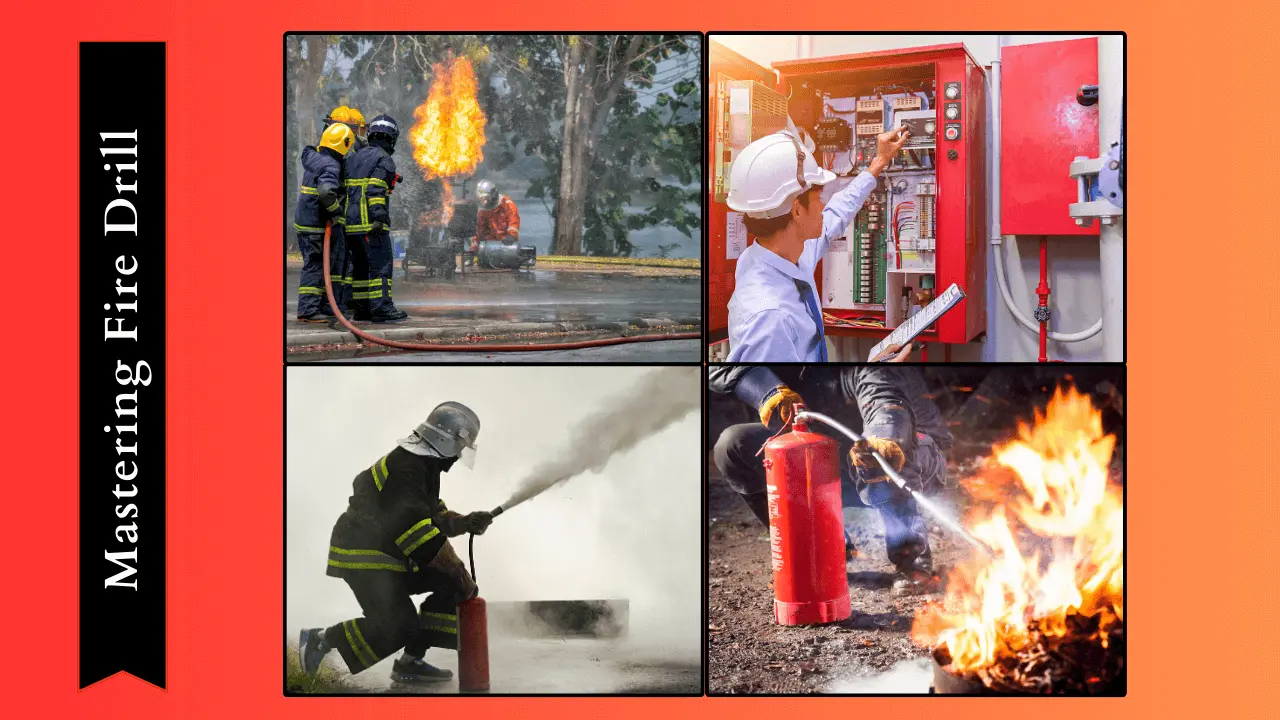
Mastering Fire Drill: Safety Tips and Best Practices for Your Business
Have you ever thought about what would happen if a fire suddenly broke out in your workplace? Would your team know exactly what to do? This is why a fire drill is crucial for every business organization. It provides essential knowledge and training to act and fight fire circumstances.
It provides knowledge on safe evacuation, identifying fire protection & detection elements, and other safe practices to avoid fatalities. A fire drill helps safeguard employees, customers, general visitors, and the physical assets of an organization from fire occurrences. It's better to conduct the fire drill frequently, which ensures proper awareness among the business stakeholders.
Ready to transform your workplace safety from risky to resilient? Let's explore.
Purpose of The Article
The main purpose of this article is to provide necessary safety guides and best practices for mastering the fire drill. So that all relevant parties will understand fire safety practices and behaviors to safeguard themselves and their business assets.
A fire drill is a comprehensive guide that provides knowledge and practical guidance to the required parties. This includes explaining basic fire elements, safe evacuation procedures, methods of utilizing fire equipment, and many more.
Understanding the consequences of fire is important to prevent life and property losses. This article can enlighten the wisdom to mitigate these issues related to fire.
Importance of A Fire Drill
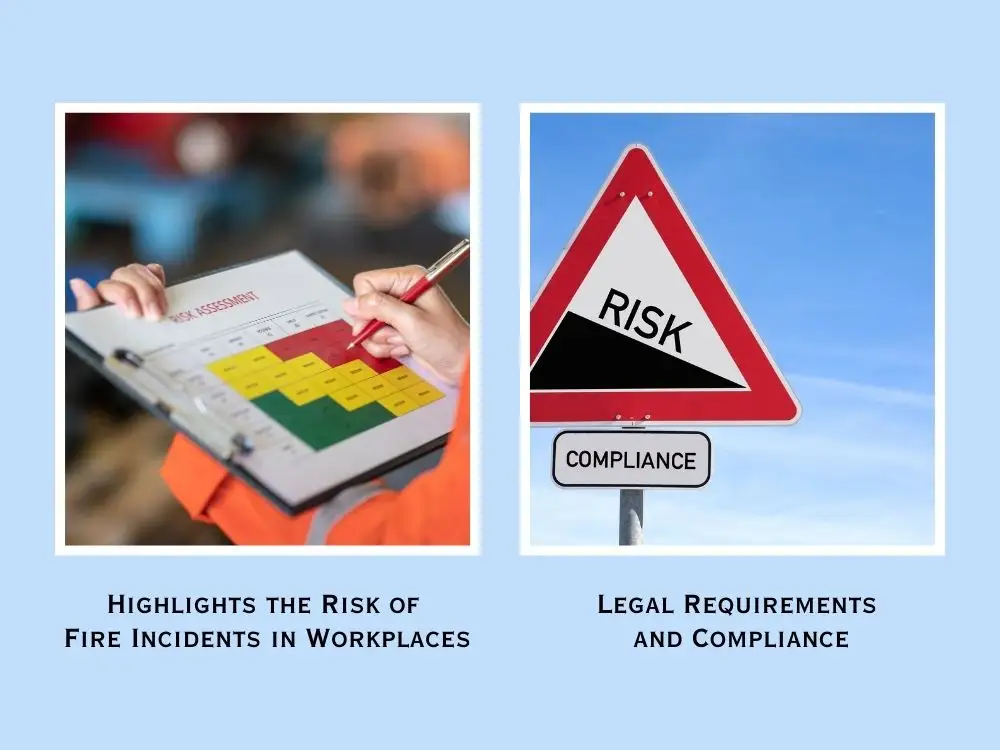
Highlights the Risk of Fire Incidents in Workplaces
Conducting a fire drill is crucial to highlight the risk of fire incidents that are possible to occur at the business premises. It's essential to prepare the facility and its employees before a fire occurrence takes place.
Fire incidents are very risky because of their ability to cause catastrophic damage to properties and individuals. It's more than what we think. Therefore, every organization should be vigilant and aware of conducting fire drills. This will help them make sure the organization is well-prepared against devastating fire incidents.
Moreover, a fire drill is inevitable to help occupants act accordingly, such as avoiding panic and following necessary rules when there is a fire in the building. This helps reduce fatalities if a fire catches the building.
Legal Requirements and Compliance
Conducting a fire drill helps businesses comply with vital legal requirements and fire safety regulations. These legal requirements mandate the necessary protection of human lives and business properties that can be significantly affected by fire occurrences.
A fire drill ensures appropriate legal and safety compliance with adequate measures and practices. Further, every business must keep its employees and its surroundings safe to avoid legal penalties and compensation. This is where fire drills help mitigate this issue and ensure compliance and business reputation.
How to Conduct A Fire Drill?
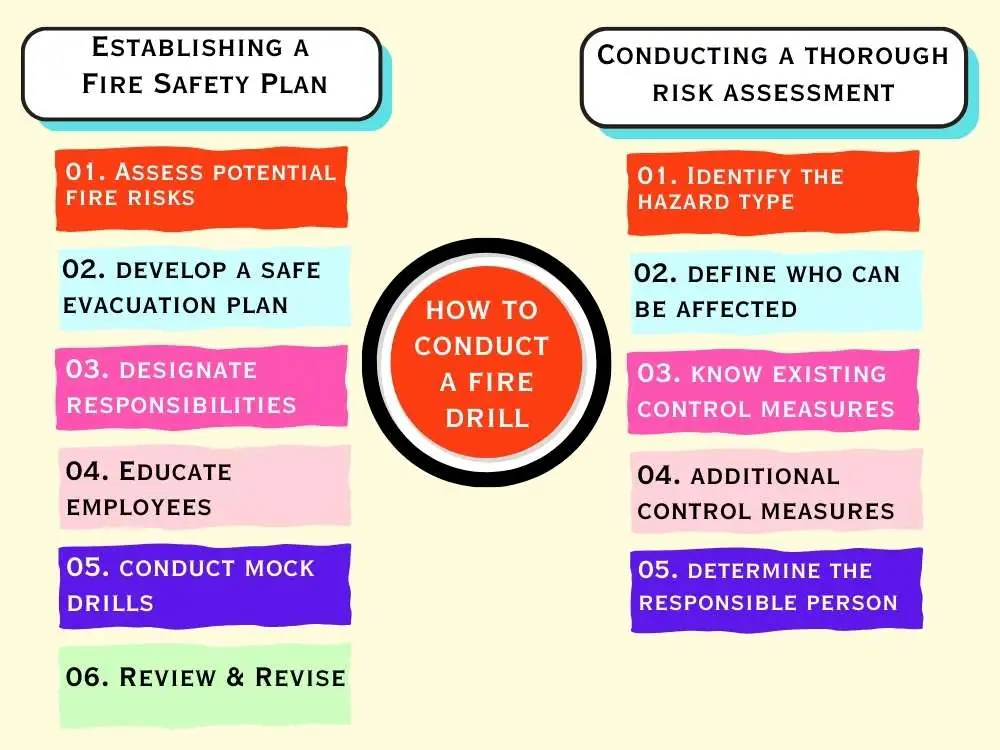
Establishing a Fire Safety Plan
To conduct a fire drill, establishing a fire safety plan is the initial stage, which improves safety at the workplace. In a fire safety plan, there are essential components that organizations must include to enhance the drill's practicality and success. Let's see them:
- Assess potential fire risks: Assessing the workplace for all kinds of fire risk possibilities, such as flammable materials, blasting equipment such as boilers, flammable gases, unwanted housekeeping stuff, electrical leakages, flammable liquids like diesel, petrol, and many others. These fire-causing elements are risky and cause severe damage to the business.
- Develop a safe evacuation plan: The evacuation plan is a vital map that guides building occupants to the safest exit point in a fire circumstance. This evacuation plan should be very clear and understandable by every individual with simple illustrations. The evacuation route should be illuminated with emergency lights and free from obstructions.
- Designate responsibilities: The organization should delegate duties to the designated professionals who have adequate job skills and experience in fire safety. This helps lead and conduct a fire drill and train others on fire safety practices.
- Educate employees: It's vital to educate the employees on all fire safety practices. It includes safe evacuation, proper utilization of fire extinguishers, types of fire, proper suppression methods, and vital things to avoid in fire circumstances, like using elevators.
- Conduct mock drills: This is important to measure whether the fire drill is up to the required standard level. Also, it helps test response time and coordination from the employees and other people at the workplace.
- Review and revise: After conducting the fire drill, businesses should evaluate the results to find areas for improvement. This identification helps revise the fire safety plans and make necessary adjustments to make them effective.
To prepare for a fire drill, a complete fire safety plan is crucial, and it helps improve fire safety and minimize risks in the organization.
Conducting a Thorough Risk Assessment
A thorough risk assessment ensures proper identification of fire risks at the workplace. Plus, it helps implement the best strategies to control them. A risk assessment is a comprehensive document that manifests detailed information regarding fire hazards, people who are affected, existing control measures, further control measures, and the responsible person (s) for implementing the control measures.
For example, if there is a chance for a risk event through flammable materials at the workplace, then the risk assessment can document this entry as below:
- Hazard type: Flammable materials (Can cause a fire)
- Who can be affected: All individuals at the workplace
- Existing control measure: Affixed stickers describing “flammable materials”
- Additional control measures: Proper Isolation of materials, proper storage, authorized access only to handle materials, etc.
- Responsible person: Store manager, Building Manager
As in the above simple and precise example, a risk assessment document elaborates the information in detail for easy understanding. This is helpful to effectively plan and control fire risk at the workplace and minimize catastrophic damage.
Educating Employees on The Fire Drill
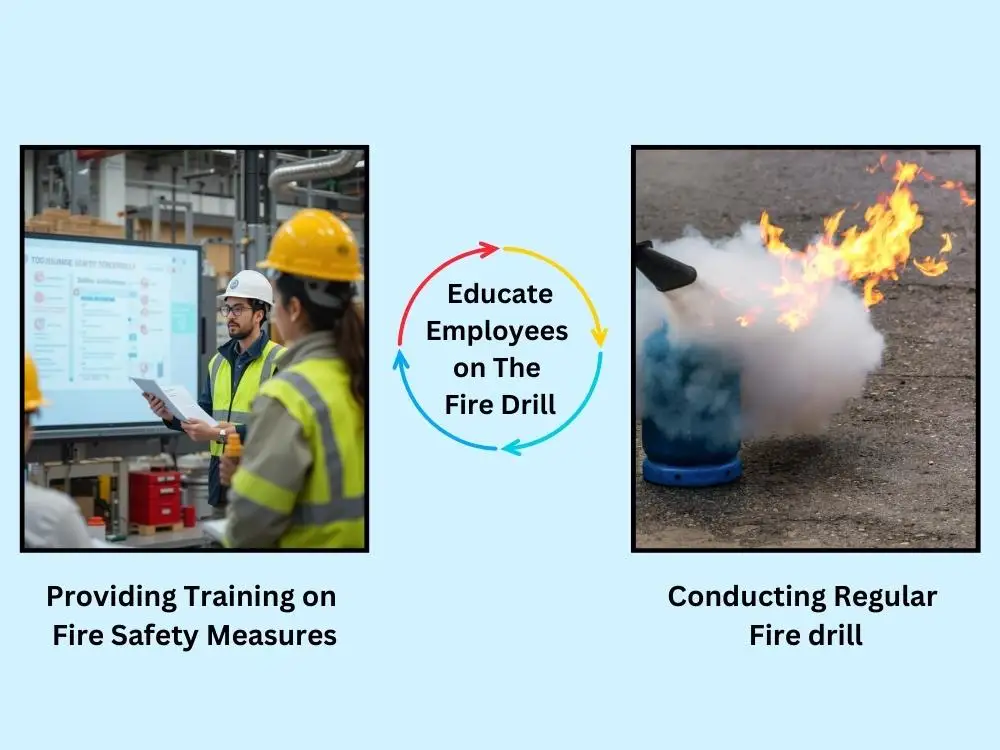
Providing Training on Fire Safety Measures
Organizations have to educate employees to avoid unnecessary consequences at the workplace, such as damage to physical assets and humans. Here are some essential things that should be covered in the training:
A) Educating employees on different types of fires and extinguishing methods: Fire is possible to occur when 3 elements merge together. This is known as “a fire triangle” that includes combustible material, heat, and oxygen. The type of fire differs according to the presence of the different combustible elements, such as:
- Type A: Paper, wood, cardboard, etc.
- Type B: Flammable Liquids
- Type C: Flammable Gases
- Type D: Combustible metals
- Type E: Electrical
- Type F: Cooking Oil and fats
According to the type of fire, the extinguishing methods differ as below:
- Type A: This type of fire involves combustible elements like paper, clothes, or wood. Generally, water is used to eliminate the heat from the fire triangle to suppress the fire.
- Type B: This type of fire can be extinguished using CO2, Foam, and ABC dry powder types of extinguishers. It's good to utilize foam.
- Type C: The ABC dry powder type is used.
- Type D: It’s hard to suppress this type of fire. Can get assistance from the fire authority.
- Type E: CO2 and ABC dry powder are used to extinguish the fire.
- Type F: Wet chemical is used for this type of fire.
It's important to use appropriate fire extinguishing methods to suppress fire, where inappropriate application can worsen the situation. For example, if a water-type extinguisher is used for an electrical fire, it can cause huge damage by spreading the fire to even more premises.
Therefore, it's inevitable to educate employees to make them aware and identify the best methods to extinguish the fire. If not, the situation may get worse.
B) Promoting awareness of emergency exit locations:
Promoting awareness among the employees regarding emergency exit points helps them identify safe evacuation methods when there is any chance of fire occurrence. This awareness program should include proper guidelines that include follow and no-follow methods of exit in a fire circumstance.
For example, people should not use elevators in a fire circumstance where power failures are possible to occur and they can get stuck inside the building. It's necessary to use the proper emergency exit staircase to evacuate. These emergency exits should be facilitated with the best lighting, ventilation, and fire-resistant doors.
Conducting Regular Fire drill
Conducting the fire drill more often ensures proper knowledge sharing with the employees regarding fire safety measures. A fire drill covers every aspect regarding fire protection and detection of a building and illustrates things like:
- How to operate fire extinguishers
- Safe evacuation methods
- Important contact numbers for emergencies, such as the fire service department and the internal responsible persons' numbers.
- Proper communication to fire panels using fire phones
- Identification of fire detection elements such as smoke detectors, heat detectors, and manual call points
- Identification of fire protection elements like sprinklers, fire hydrants, hose reels, and so on.
This can be a comprehensive fire drill training that employees need to get trained to safeguard themselves and the business property from fire consequences.
Executing Fire Drill
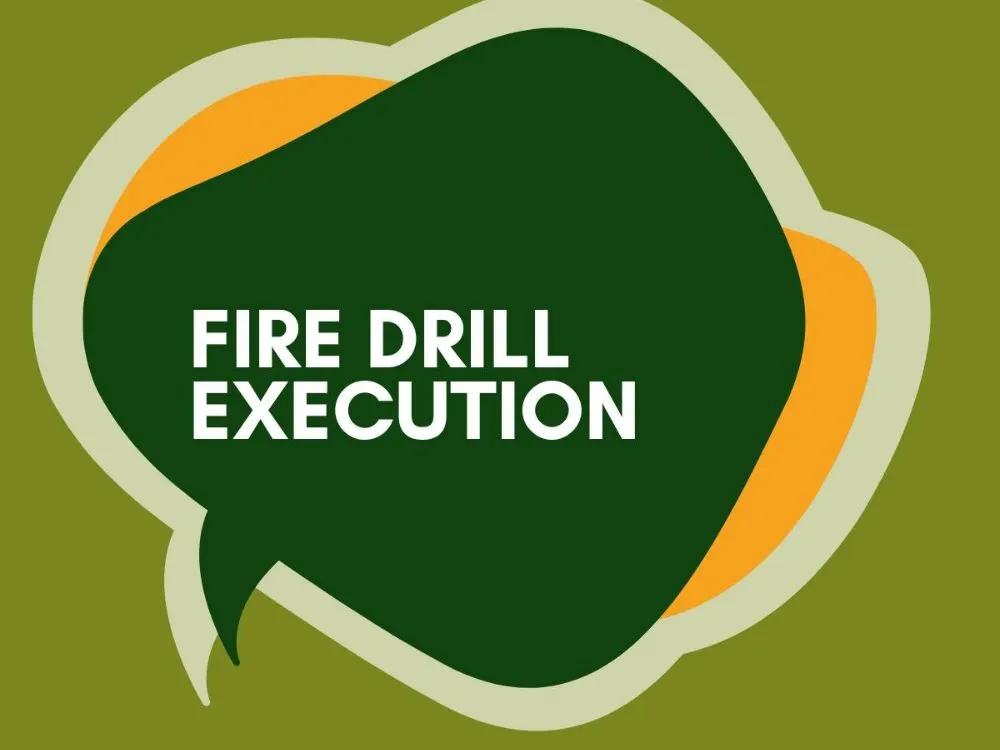
Promoting a Calm and Efficient Response During the Fire Drill
Executing a fire drill in an organization needs a calm and efficient response from the occupants during the procedure. All occupants in the building should cooperate with the fire drill procedure and provide adequate support to conduct it as a successful program.
Employees shouldn’t panic about fire alarms or other awareness programs during the fire drill, which encourages the trainers to provide a clear illustration. Moreover, employees should follow an orderly evacuation procedure to avoid other risk consequences, such as trips and falls.
Finally, the fire drill outcomes should be measured, as it helps identify common pitfalls and areas of improvement needed. This helps plan the next fire drill procedure.
Addressing Specific Scenarios and Challenges
When executing the fire drill, it's necessary to address specific scenarios and challenges that could be helpful to rectify and enhance the upcoming fire drill. Some simulated scenarios, like blocked exits or power failures, can cause significant problems in a comprehensive fire drill.
Obstructions in the emergency exits and power failures can impact evacuation procedures during the fire drill practice. Also, one more major challenge is the difficulty of integrating strategies for aiding individuals with disabilities. However, it's vital to consider disabled people for complete protection.
Reviewing and Improving Fire Safety
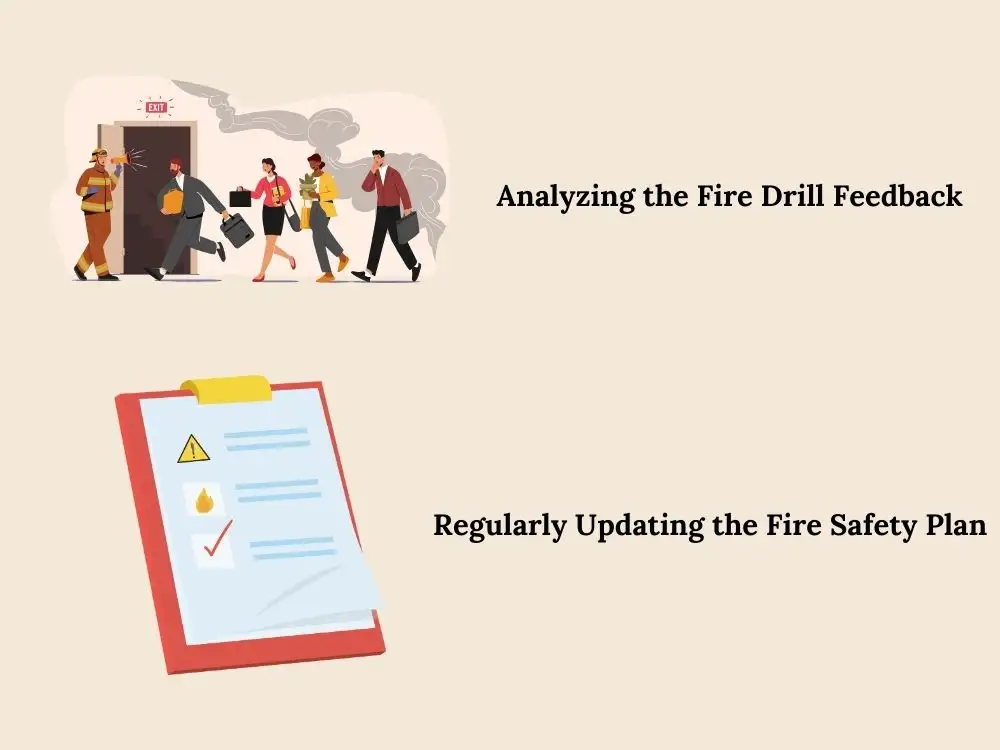
Analyzing the Fire Drill Feedback and Observations
This is efficient in improving fire safety at the workplace. It's important to gather feedback from all employees and conduct post-drill discussions. This will enable the identification of how well the fire drill was performed and transfer necessary knowledge to the relevant parties.
Analyzing feedback is an essential review procedure that provides ample information regarding the observations, challenges, and areas that need improvement in the workplace. Therefore, every business should conduct a detailed feedback analysis right after conducting fire drills to make necessary arrangements and improve safety.
Regularly Updating the Fire Safety Plan
After a careful analysis, businesses must update their fire safety plan based on the mandatory requirements that they should adhere to the changing building codes and regulations.
Also, performing necessary rectifications internally will modify plans based on changes and renovations at the workplace. Regular updates of fire safety plans help prevent risks arising, exposures, and unnecessary incident possibilities.
Therefore, organizations should consider updating their fire safety plan as per the changes that take place according to the identification. This will eventually improve overall fire safety at the workplace.
Wrapping Up
Fire safety is a paramount element of every workplace. Businesses should have sufficient safety measures to safeguard the people, properties, and surroundings from major fire risks. A Fire drill is a complete foundation to provide fire safety at the workplace that contains essential training in safe evacuation, identification of fire equipment, and utilization of extinguishers and other fire safety procedures.
It also guides people to act vigilantly without panic in any fire circumstances. Preparing for the fire drill starts with a fire safety plan and conducting a thorough risk assessment. Also, a fire drill should be conducted frequently to enhance their reach to the relevant parties.
Further, educating the employees on behalf of fire drills and safe procedures is crucial. Reviewing it helps identify key areas that need improvement, and it makes the upcoming fire drill more effective with necessary changes and renovations.
FAQs
Q1: How does a fire drill highlight fire incident risks?
By simulating fire scenarios, a fire drill can raise awareness about fire risks, helping occupants stay prepared and avoid panic.
Q2: How can businesses conduct and prepare a fire drill?
Preparing involves a fire safety plan, risk assessments, employee education, and regular drills for improvement.
Q3: How can businesses educate employees on fire safety?
Organizations can educate employees by providing fire-type training, the right extinguisher use and identification, and promoting awareness of emergency exits.
Q4: Why is regularly updating the fire safety plan important?
Regularly updating the fire safety plan ensures compliance with regulations and addresses changes in the workplace.
Explore Related Posts
https://smarttoolsai.com/post/exploring-waste-management-and-thriving-careers-in-the-industry
https://smarttoolsai.com/post/workspace-optimization-mastering-space-management
.webp)